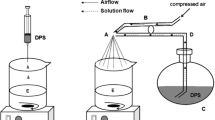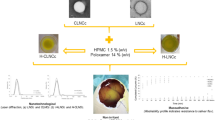Abstract
Purpose
The objective of this study was to prepare gelatin/oxidized alginate (OAlg) hydrogel incorporating chitosan (CS)/alginate (Alg) microparticles (MPs) for topical delivery of crocin and maintaining MPs at the target site.
Methods
Crocin-loaded MPs were prepared using the ionic gelation method, and the effects of CS, Alg, and tripolyphosphate (TPP) concentrations on particle size and entrapment efficiency% (EE) were evaluated by applying a factorial design. OAlg was synthesized, and the optimum MP formulation was loaded into gelatin/OAlg hydrogel. The developed formulation was characterized in terms of morphology, chemical structure, crystallinity, thermal behavior, viscosity, swelling behavior, mucoadhesion, and in vitro release profile.
Results
The designed particles had a size ranging from 7.2 to 47.8 µm with the EE results varying between 12.5 and 58.4%. The mathematical models with suitable determination coefficients (R2) were established which confirmed a satisfactory correlation between the independent variables and the results. The optimized formulation showed a particle size of ~ 28 µm and a zeta potential of ~ 24 mV with about 58% crocin entrapment. The successful oxidation process was confirmed by the appearance of aldehyde peak in FTIR spectroscopy, and the oxidation degree (OD) of prepared OAlg was found to be about 62%. The prepared complex could release crocin in a sustained manner through 48 h and showed superior mucoadhesive strength, compared to gelatin/Alg-based hydrogel.
Conclusion
The fabricated gelatin/OAlg hydrogel containing CS/Alg MPs exhibited the promising potential to be utilized in mucosal delivery applications.
Graphical Abstract








Similar content being viewed by others
Data Availability
The datasets generated and/or analyzed during the current study are available from the corresponding author on reasonable request.
References
Song Y-N, et al. Crocins: A comprehensive review of structural characteristics, pharmacokinetics and therapeutic effects. Fitoterapia. 2021;153:104969.
Pashirzad M, et al. Therapeutic potency of crocin in the treatment of inflammatory diseases: Current status and perspective. J Cell Physiol. 2019;234(9):14601–11.
Fagot D, et al. Crocin, a natural molecule with potentially beneficial effects against skin ageing. Int J Cosmet Sci. 2018;40(4):388–400.
Alemzadeh E, Oryan A. Effectiveness of a Crocus sativus extract on burn wounds in rats. Planta Med. 2018;84(16):1191–200.
Kocaman G, et al. Protective effects of crocin on biochemistry and histopathology of experimental periodontitis in rats. Biotechnic & histochemistry : official publication of the Biological Stain Commission. 2019;94(5):366–73.
Tsimidou M, Biliaderis CG. Kinetic studies of saffron (Crocus sativus L.) quality deterioration. J Agri Food Chem. 1997;45(8):2890–2898.
Esposito E, et al. Ethosomes and organogels for cutaneous administration of crocin. Biomed Microdevices. 2016;18(6):108.
Esposito E, et al. Nanostructured lipid dispersions for topical administration of crocin, a potent antioxidant from saffron (Crocus sativus L.). Mater Sci Eng C Mater Biol Appl. 2017;71:669–77.
Zeka K, et al. New hydrogels enriched with antioxidants from saffron crocus can find applications in wound treatment and/or beautification. Skin Pharmacol Physiol. 2018;31(2):95–8.
Lagreca E, et al. Recent advances in the formulation of PLGA microparticles for controlled drug delivery. Prog Biomater. 2020;9(4):153–74.
Rahaiee S, et al. Nanoparticles based on crocin loaded chitosan-alginate biopolymers: Antioxidant activities, bioavailability and anticancer properties. Int J Biol Macromol. 2017;99:401–8.
Wong CY, Al-Salami H, Dass CR. Microparticles, microcapsules and microspheres: a review of recent developments and prospects for oral delivery of insulin. Int J Pharm. 2018;537(1–2):223–44.
Niculescu AG, Grumezescu AM. Applications of chitosan-alginate-based nanoparticles-an up-to-date review. Nanomaterials (Basel). 2022;12(2):186.
Caetano LA, Almeida AJ, Gonçalves LM. Effect of experimental parameters on alginate/chitosan microparticles for BCG encapsulation. Mar Drugs. 2016;14(5):90.
Ruvinov E, Cohen S. Alginate biomaterial for the treatment of myocardial infarction: Progress, translational strategies, and clinical outlook: from ocean algae to patient bedside. Adv Drug Deliv Rev. 2016;96:54–76.
Pedroso-Santana S, Fleitas N. Ionotropic gelation method in the synthesis of nano/microparticles for biomedical purposes. Polym Int. 2020;69:443–7.
Gao W, et al. Nanoparticle-hydrogel: a hybrid biomaterial system for localized drug delivery. Ann Biomed Eng. 2016;44(6):2049–61.
Nunes D, et al. Polymeric nanoparticles-loaded hydrogels for biomedical applications: a systematic review on in vivo findings. Polymers (Basel). 2022;14(5):1010.
Geng Z, et al. Preparation and characterization of a dual cross-linking injectable hydrogel based on sodium alginate and chitosan quaternary ammonium salt. Carbohydr Res. 2021;507:108389.
Tao J, et al. Injectable chitosan-based thermosensitive hydrogel/nanoparticle-loaded system for local delivery of vancomycin in the treatment of osteomyelitis. Int J Nanomedicine. 2020;15:5855–71.
Baniasadi H, et al. Design, fabrication and characterization of oxidized alginate-gelatin hydrogels for muscle tissue engineering applications. J Biomater Appl. 2016;31(1):152–61.
Reakasame S, et al. Biofabrication and characterization of alginate dialdehyde-gelatin microcapsules incorporating bioactive glass for cell delivery application. Macromol Biosci. 2020;20(10): e2000138.
Petros S, Tesfaye T, Ayele M. A review on gelatin based hydrogels for medical textile applications. J Eng. 2020.
Reakasame S, Boccaccini AR. Oxidized Alginate-based hydrogels for tissue engineering applications: a review. Biomacromol. 2018;19(1):3–21.
Mohabatpour F, et al. Self-crosslinkable oxidized alginate-carboxymethyl chitosan hydrogels as an injectable cell carrier for in vitro dental enamel regeneration. J Funct Biomater. 2022;13(2):71.
Chen Y, et al. A biocompatible, stimuli-responsive, and injectable hydrogel with triple dynamic bonds. Molecules. 2020;25(13):3050.
De Caro V, et al. Aloin delivery on buccal mucosa:ex vivostudies and design of a new locoregional dosing system. Drug Dev Ind Pharm. 2014;41(9):1541–7.
Farzinfar E, Paydayesh A. Investigation of polyvinyl alcohol nanocomposite hydrogels containing chitosan nanoparticles as wound dressing. Int J Polym Mater Polym Biomater. 2018;68:1–11.
Ren B, et al. Injectable polysaccharide hydrogel embedded with hydroxyapatite and calcium carbonate for drug delivery and bone tissue engineering. Int J Biol Macromol. 2018;118(Pt A):1257–66.
Vieira EF, et al. Polysaccharide-based hydrogels: preparation, characterization, and drug interaction behaviour. Biomacromol. 2008;9(4):1195–9.
Sarker B, et al. Fabrication of alginate-gelatin crosslinked hydrogel microcapsules and evaluation of the microstructure and physico-chemical properties. J Mater Chem. 2014;2(11):1470–82.
Lee FY, Htar T, Akowuah G. ATR-FTIR and spectrometric methods for the assay of crocin in commercial saffron spices (Crocus savitus L.). Int J Food Prop. 2014;18:1773–1783.
Rahaiee S, et al. Improvement of crocin stability by biodegradeble nanoparticles of chitosan-alginate. Int J Biol Macromol. 2015;79:423–32.
Gjoseva S, et al. Design and biological response of doxycycline loaded chitosan microparticles for periodontal disease treatment. Carbohydr Polym. 2018;186:260–72.
Chandrasekar V, Coupland JN, Anantheswaran RC. Characterization of nisin containing chitosan-alginate microparticles. Food Hydrocoll. 2017;69:301–7.
Martin-Saldana S, et al. Salicylic acid loaded chitosan microparticles applied to lettuce seedlings: Recycling shrimp fishing industry waste. Carbohydr Polym. 2018;200:321–31.
Emami Z, et al. Controlling alginate oxidation conditions for making alginate-gelatin hydrogels. Carbohydr Polym. 2018;198:509–17.
Abou-Zeid RE, et al. Oxidized alginate/gelatin decorated silver nanoparticles as new nanocomposite for dye adsorption. Int J Biol Macromol. 2019;141:1280–6.
Mukhopadhyay P, et al. Oral delivery of quercetin to diabetic animals using novel pH responsive carboxypropionylated chitosan/alginate microparticles. RSC Adv. 2016;6(77):73210–21.
Mehryab,F, Taghizadeh F, Haeri A. Preparation and in vitro characterization of crocin-loaded casein hydrogels: crocin-loaded casein hydrogels. Trends Pept Protein Sci. 2022;7:1–9(e3).
Banach M, et al. A chemical method of the production of “heavy” sodium tripolyphosphate with the high content of Form I or Form II. Pol J Chem Technol. 2009;11:13–20.
Wang H, et al. A study on the correlation between the oxidation degree of oxidized sodium alginate on its degradability and gelation. Polymers (Basel). 2022;14(9):1679.
Manzon D, et al. Quality by design: comparison of design space construction methods in the case of design of experiments. Chemom Intell Lab Syst. 2020;200:104002.
Cunha S, et al. Using the quality by design (QbD) approach to optimize formulations of lipid nanoparticles and nanoemulsions: A review. Nanomedicine. 2020;28:102206.
Omar Zaki SS, Ibrahim MN, Katas H. Particle size affects concentration-dependent cytotoxicity of chitosan nanoparticles towards mouse hematopoietic stem cells. J Nanotech. 2015:1–5.
Katas H, Alpar HO. Development and characterisation of chitosan nanoparticles for siRNA delivery. J Control Release. 2006;115(2):216–25.
Xu Y, Hanna MA. Electrosprayed bovine serum albumin-loaded tripolyphosphate cross-linked chitosan capsules: synthesis and characterization. J Microencapsul. 2007;24(2):143–51.
Stagner WC, et al. Human volunteer, in vitro, and molecular level evaluation of an optimized taste-masked isoniazid-chitosan spray-dried microparticle matrix. Int J Pharm. 2019;572:118774.
Palma E, et al. Improvement of the therapeutic treatment of inflammatory bowel diseases following rectal administration of mesalazine-loaded chitosan microparticles vs Asamax®. Carbohyd Polym. 2019;212:430–8.
Tang ZX, Qian JQ, Shi LE. Preparation of chitosan nanoparticles as carrier for immobilized enzyme. Appl Biochem Biotechnol. 2007;136(1):77–96.
Lacerda L, et al. Development and evaluation of pH-sensitive sodium alginate/chitosan microparticles containing the antituberculosis drug rifampicin. Mater Sci Eng C Mater Biol Appl. 2014;39:161–7.
Zhou L, et al. Hybrid gelatin/oxidized chondroitin sulfate hydrogels incorporating bioactive glass nanoparticles with enhanced mechanical properties, mineralization, and osteogenic differentiation. Bioact Mater. 2021;6(3):890–904.
Carvalho FC, et al. Rheological, mechanical, and bioadhesive behavior of hydrogels to optimize skin delivery systems. Drug Dev Ind Pharm. 2013;39(11):1750–7.
Modaresifar K, Hadjizadeh A, Niknejad H. Design and fabrication of GelMA/chitosan nanoparticles composite hydrogel for angiogenic growth factor delivery. Artif Cells Nanomed Biotechnol. 2018;46(8):1799–808.
Wang Q, Wang Q, Teng W. Injectable, degradable, electroactive nanocomposite hydrogels containing conductive polymer nanoparticles for biomedical applications. Int J Nanomedicine. 2016;11:131–44.
Cao L, et al. Bone regeneration using photocrosslinked hydrogel incorporating rhBMP-2 loaded 2-N, 6-O-sulfated chitosan nanoparticles. Biomaterials. 2014;35(9):2730–42.
Afshar M, et al. Preparation and characterization of sodium alginate/polyvinyl alcohol hydrogel containing drug-loaded chitosan nanoparticles as a drug delivery system. J Drug Deliv Sci Technol. 2020;56:101530.
Cui CL, et al. Development of sustainable carrier in thermosensitive hydrogel based on chitosan/alginate nanoparticles for in situ delivery system. Polym Compos. 2018;40(6):2187–96.
Li DD, et al. Characterization and cytocompatibility of thermosensitive hydrogel embedded with chitosan nanoparticles for delivery of bone morphogenetic protein-2 plasmid DNA. JMat Scie Mat Med. 2016;27(8):134.
Moreno JAS, et al. Development of electrosprayed mucoadhesive chitosan microparticles. Carbohydr Polym. 2018;190:240–7.
Kumar A, et al. Mucoadhesive formulations: innovations, merits, drawbacks, and future outlook. Pharm Dev Technol. 2020;25(7):797–814.
Funding
This study was supported by the Protein Technology Research Center, Shahid Beheshti University of Medical Sciences, Tehran, Iran.
Author information
Authors and Affiliations
Corresponding author
Ethics declarations
Competing Interests
The authors declare no competing interests.
Additional information
Publisher's Note
Springer Nature remains neutral with regard to jurisdictional claims in published maps and institutional affiliations.
Supplementary Information
Below is the link to the electronic supplementary material.
Rights and permissions
Springer Nature or its licensor (e.g. a society or other partner) holds exclusive rights to this article under a publishing agreement with the author(s) or other rightsholder(s); author self-archiving of the accepted manuscript version of this article is solely governed by the terms of such publishing agreement and applicable law.
About this article
Cite this article
Merati, F., Mehryab, F., Mortazavi, S.A. et al. An Experimental Design Approach for Development of Crocin-Loaded Microparticles Embedded in Gelatin/Oxidized Alginate-Based Hydrogel. J Pharm Innov 18, 1812–1826 (2023). https://doi.org/10.1007/s12247-023-09755-0
Accepted:
Published:
Issue Date:
DOI: https://doi.org/10.1007/s12247-023-09755-0




